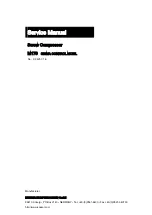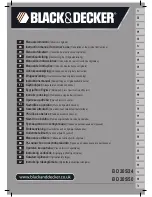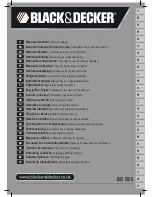
FORM 220.11-NM2 (602)
35
YORK INTERNATIONAL
4
age so the sump can be maneuvered up and down. It
may sag down to the rear from the eyebolt and needs
leveling. Special care must be taken to protect the oil
seals from damage during this process. Use protective
sleeves to protect probes, if applicable. Failure to com-
ply will result in damage to probes.
All compressor components are drilled and tapped for
lifting eyes. Use forged eyebolts and make sure they
are screwed into the shoulder. Use washers if required.
Extended shanks can bend and break. Don’t use home-
made lifting eyes. Use only approved devices rated for
the weight of the component being lifted.
Utilize containers to segregate bolts, screws and wash-
ers. Keep a log and true count of all small items. Coat
all parts with oil and cover with paper or plastic for
protection from weather or dirt.
SERVICE REQUIRING OPENING THE
COMPRESSOR
Before opening the compressor, try to determine if you re-
ally need to go inside the machine. Some of the valid rea-
sons requiring internal inspection or repairs are listed below:
A. Excessive shaft seal leakage of oil or refrigerant.
B. Routine bearing inspection.
(Customer requested/mandated)
C. Aluminum particles in the oil filter.
Thrust oil to the oil cooler is not al-
ways filtered. Small amounts of alu-
minum may be signs of significant
thrust bearing failure.
D. Oil loss into the compressor.
E. Rapid or gradual increase in compressor
vibration.
F. Excessive balance piston pressure relative to
the equalizing stage.
G. High discharge temperature relative to the suc-
tion and side load temperatures.
The conditions listed above are some of the more com-
mon symptoms and problems. Some of the possible
causes are listed below.
Conditions A, B, and C can be checked without remov-
ing the compressor drive shaft. If condition C reveals
particulate aluminum in the oil filter, it is advisable to
drain the oil and inspect the thrust bearing and journal
bearings.
Condition D may require removal of the compressor
drive shaft and suction end bearing housing if external
factors, such as oil dilution, sump pressure and exter-
nal seal gas pressure (A-4) seal are found to be correct.
Scoring or wearing of the suction end inboard A-1 oil
seal can result in oil loss into the compressor and you
must pull the PRV sleeve to verify it.
Condition E can be caused by poor alignment, extreme
variations of oil pressure and temperature, liquid refrig-
erant entering the compressor suction or side loads, dis-
placed oil pump collar if observed by vibration probes or
unbalanced rotor. Rotor unbalance may be the result of
excessive bearing wear, wheel erosion, encrustation of
wheels with system dirt, physical damage to the wheels
from foreign objects or contact with an internal part the
compressor and/or excessive balance piston wear. The
rotor can make contact with the compressor internals if
severe thrust bearing failure occurs. Severe discharge and
thrust bearing failure may also cause the discharge end
inboard gas seal to fail and cause excessive foam in the
oil sump. Balance piston wear is usually the result of
excessive surging, liquid refrigerant carry-over, or sys-
tem dirt entrained in the gas flow. The top half must be
lifted if rotor damage is suspected.
Condition F is suspected if the balance piston chamber
pressure is more than 10 lbs above the design pressure
or the delta approaches the maximum value listed on
the drawing, assuming all external conditions are nor-
mal. A rising balance piston pressure coupled with an
increase in thrust oil temperature to more than 25°F
above the supply oil temperature to the bearings, indi-
cates the thrust bearing is carrying increasing thrust
load. A worn balance piston seal ring is the most prob-
able cause. The sump must be removed to reach the
balance piston and discharge end gas seals.
Condition G may indicate excessive shaft labyrinth seal
and/or impeller inlet seal(s) wear. Assuming external
conditions are normal, the condition will usually be
accompanied by a loss in compressor capacity and pos-
sibly a rise in discharge temperature along with an in-
crease in compressor horsepower. The compressor top
half must be lifted for inspection of the shaft and impel-
ler seals. Analyze for elevated system temperatures
before condemning the compressor efficiency.
Содержание Turbomaster M 255
Страница 9: ...FORM 220 11 NM2 602 9 YORK INTERNATIONAL FIG 2 TYPICAL COMPRESSOR CROSS SECTIONAL VIEW LD07317 1...
Страница 15: ...FORM 220 11 NM2 602 15 YORK INTERNATIONAL FIG 3 TYPICAL PRIMARY COMPRESSOR GAS FLOW LD07318 3...
Страница 16: ...YORK INTERNATIONAL 16 FORM 220 11 NM2 602 FIG 4A MAJOR COMPONENTS LD07319 Operation...
Страница 31: ...FORM 220 11 NM2 602 31 YORK INTERNATIONAL Operation 3 This page intentionally left blank...
















































